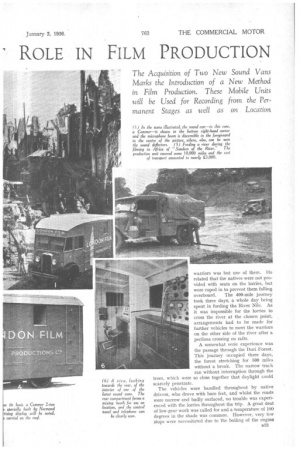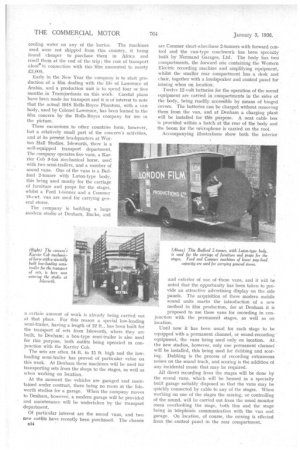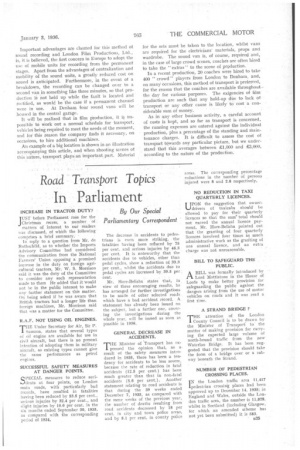ROAD TRANSPORT'S IMPORTA ROLE IN FILM PRODUCTION
Page 42

Page 43

Page 44

Page 45

If you've noticed an error in this article please click here to report it so we can fix it.
The Transport Department of London Film Productions, Ltd., Deals with a Variety of Problems Each Day. The Carriage of Equipment and Personnel is Amongst the Functions Performed by Commercial Vehicles
The Acquisition of Two New Sound Vans Marks the Introduction of a New Method in Film Production. These Mobile Units will be Used for Recording from the Permanent Stages as well as on Location
RANSPORTING 300 native warriors, in their full war paint, a distance of 400 miles through the heart of Africa, is but one of the many tasks in which commercial vehicles have proved their value in the making of motion pictures. The incident referred to was necessitated during the filming of "Sanders of the River," when a production unit of London Film Productions, Ltd., spent nearly eight months in Uganda and the Belgian Congo.
Cpmprising a dozen film technicians, together with 40 native servants, the unit covered some 10;000 miles, and transport was effected by five Ford 2-tonners, three 30-cwt. vans of the same make, and a number of private cars. A good deal of equipment had to be carried, including cameras, sound apparatus and batteries for operating them, in addition to large quantities of petrol and water, food and camp equipment, as the locations were, in many cases, long distances from towns or villages.
Mr. G. Grossinith, who was in charge of the arrangements, told us of several interesting incidents that occurred during the trip, and the transport of the native B32 warriors was but one of them. He related that the natives were not provided with seats on the lorries, but were roped in to prevent them falling
overboard, The 400-mile journey took three days, a whole day being spent in fording the River Nile. As it was impossible for the lorries to at cross the river at the chosen point, arrangements had to be made for further vehicles to meet the warriors on the other side of the river after a perilous crossing on rafts.
A somewhat eerie experience was the passage through the Ituri Forest. This journey occupied three days, the forest stretching for 500 miles without a break. The narrow track ran without interruption through the trees, which were so close together that daylight could scarcely penetrate.
The vehicles were handled throughout by native drivers, who drove with bare feet, and whilst the roads were narrow and badly surfaced, no trouble was experienced with the lorries throughout the trip. A great deal of low-gear work was called for and a temperature of 100 degrees in the shade was common. However, very few stops were necessitated due to the boiling of the engine cooling water on any of the lorries. The maehines used were not shipped from this country, it being found cheaper to purchase them in Africa and resell them at the end of the trip ; the cost of transport alone in connection with this 'film amounted to nearly :e3,000.
Early in the New Year the company is to start production of a film dealing with the life of Lawrence of Arabia, and a production unit is to spend four or five months in Transjordania on this work. Careful plans have been made for transport and it is of interest to note that the actual 1918 Rolls-Royce Phantom, with a van body, used by Colonel Lawrence, has been loaned to the film concern by the Rolls-Royce company for use in the picture.
These excursions to other countries form, however, but a relatively small part of the concern's activities, and at its present headquarters at Worton Hall Studios, Isleworth, there is a well-equipped transport department. The company operates five vans, a Karrier Cob 3-ton mechanical horse, used with two semi-trailers, and a number of sound vans. One of the vans is a Bedford 2-tonner With Luton-type body, this being used mostly for the carriage of furniture and props for the stages, whilst a Ford 1-tonner and a Commer 15-cwt. van are used for carrying general stores.
The company is building a large modern studio at Denham, Bucks, and
a certain amount of work is already being carried out at that place. For this reason a special low-loading semi-trailer, having a length of 22 ft., has been built for the transport of sets from Isleworth, where they are built, to Denham; a box-type semi-trailer is also used for this purpose, both outfits being operated in conjunction with the Karrier Cob.
The sets are often 14 ft. to 15 ft. high and the lowloading semi-trailer has proved of particular value on this work. At Denham these machines wtil be used for transporting sets from the shops to the stages, as well as when working on location.
At the moment the vehicles are garaged and maintained under contract, there being no room at the Isleworth studios for a garage. When the company moves to Denham, however, a modern garage will be provided and maintenance will be undertaken by the transport department.
Of particular interest are the sound vans, and two new outfits have recently been purchased. The chassis B34 are Commer short-wheelbase 2-tonners with forward control and the van-type coachwork has been specially built by Normand Garages, Ltd. The body has two compartments, the forward one containing the Western Electric recording machine and amplifying equipment, whilst the smaller rear compartment has a desk and chair, together with a loudspeaker and control panel for mixing when on location.
Twelve 12-volt batteries for the operation of the sound equipment are carried in compartments in the sides of the body, being readily accessible by means of hinged covers. The batteries can be charged without removing them from the van, and at Denham a charging plant will be installed for this purpose. A neat cable box is provided within a hatch at the rear of the body and the boom for the microphone is carried on the roof.
Accompanying illustrations show both the interior and exterior of one of .these vans, and it will be noted that the opportunity has been taken to provide an attractive advertising display on the side panels. The acquisition of these modern mobile sound units marks the introduction of a new method in film production, for at Denham it is proposed to use these vans for recording in conjunction with the permanent stages, as well as on location.
Until now it has been usual for each stage to be equipped with a permanent channel, or sound-recording equipment, the vans being used only on location. • At the new studios, however, only one permanent channel will be installed, this being used for dubbing and scoring. Dubbing is the process of recording extraneous noises on the sound track, and scoring is the addition of any incidental music that may be required.
All direct recording from the stages will be done by the sound vans, which will be housed in a specially built garage suitably disposed so that the vans may be quickly connected by cable to any of the stages. When working on one of the stages the mixing, or controlling of the sound, will be carried out from the usual monitor room overlooking the stage, both this and the stage being in telephonic communication with the van and garage. On location, of course, the mixing is effected from the. control panel in the rear compartment.
Important advantages are claimed for this method of sound recording and London Film Productions, Ltd., is, it is believed, the first concern in Europe to adopt the use of mobile units for recording from the permanent stages. Apart from the advantages of centralization and mobility of the sound units, a greatly reduced cost on sound is anticipated. Furthermore, in the event of a breakdown, the recording can be changed over to a second van in something like three minutes, so that production is not held up while the fault is located ami rectified, as would be the case if a permanent channel were in use. At Denham four sound vans will be housed in the central garage.
It will be realized that in film Production, it is impossible to Work out a normal schedule for transport, vehicles being required to meet the needs of the moment, and for this reason the company finds it necessary, on occasions, to hire additional machines.
Ai example of a big location is shown in an illustration accompanying this article, and when shooting scenes of this nature-, transport plays=an iniport.s.nt-part. Material
for the sets must be taken to the location, whilst vans are required for the electricians' materials, props and wardrobe. The sound van is, of course, required and, in the case of large crowd scenes, coaches are often hired to take the " extras " to the scene of production.
In a recent production, 20 coaches were hired to take 400 " crowd " players from London to Denham, and, on many occasions, this method of transport is preferred, for the reason that the coaches are available throughout the day for various purposes. The exigencies of film' production are such that any hold-up due to lack of transport or anyother cause is likely to cost a considerable sum of money.
As in any other business activity, a careful account of costs is kept, and so far as transport is concerned, the running expenses are entered against the individual production, plus a percentage of the standing and Maintenance charges. It is difficult to assess the cost ot transport towards any particular picture, but we understandthat this averages between 21,000 and 23,000, according to the nature of the production.




















































































